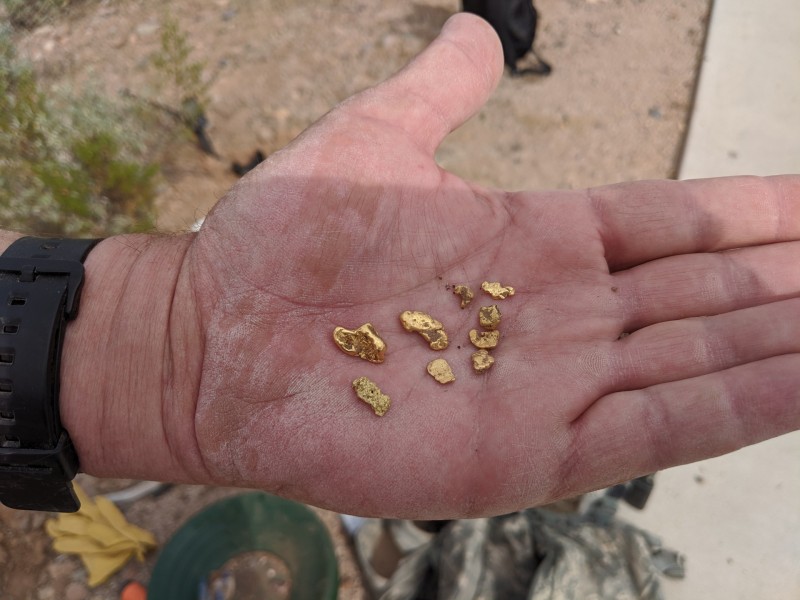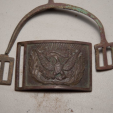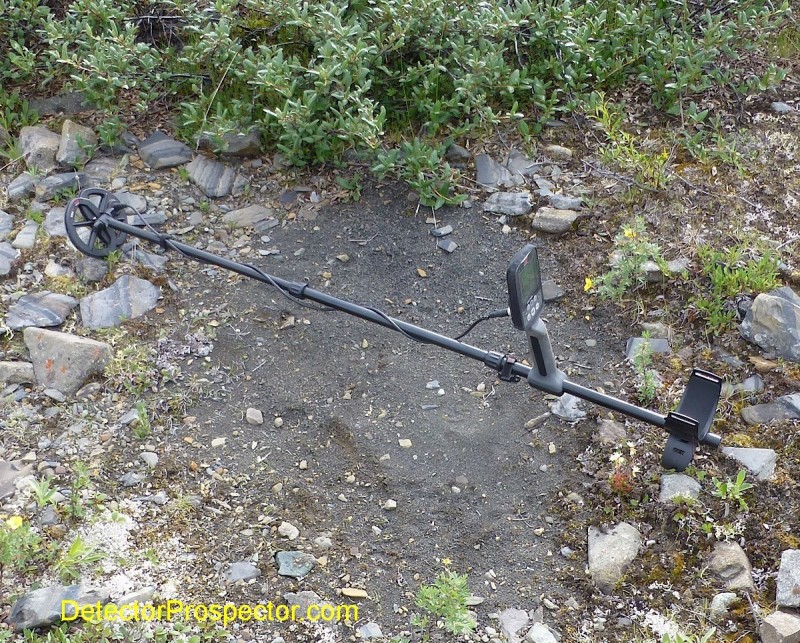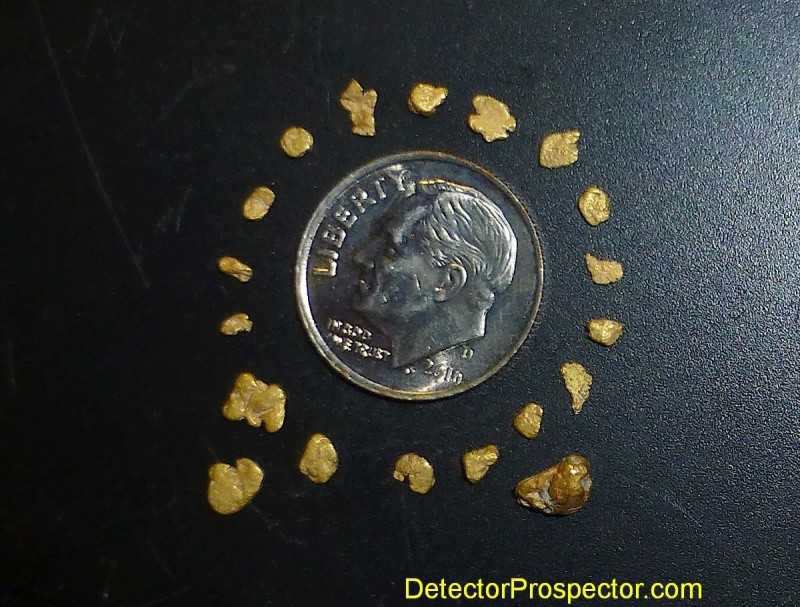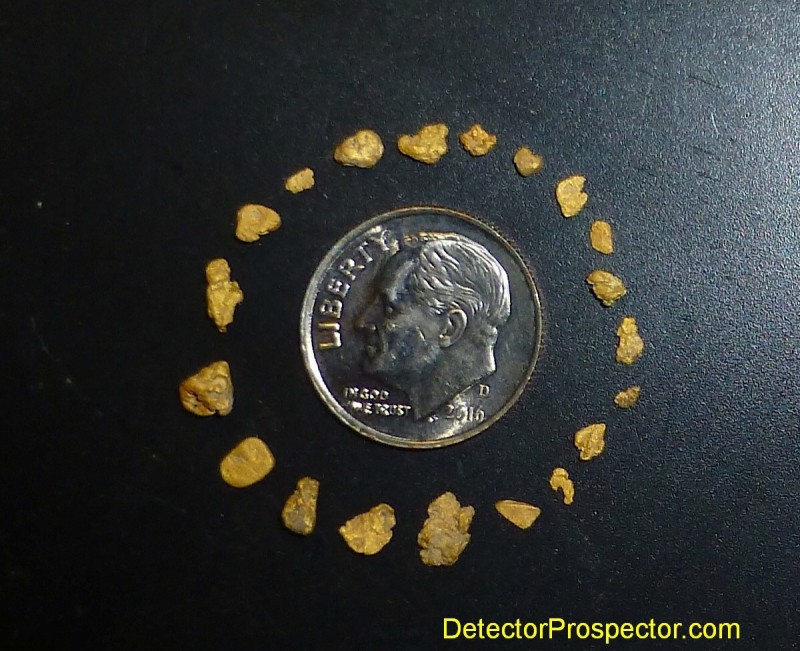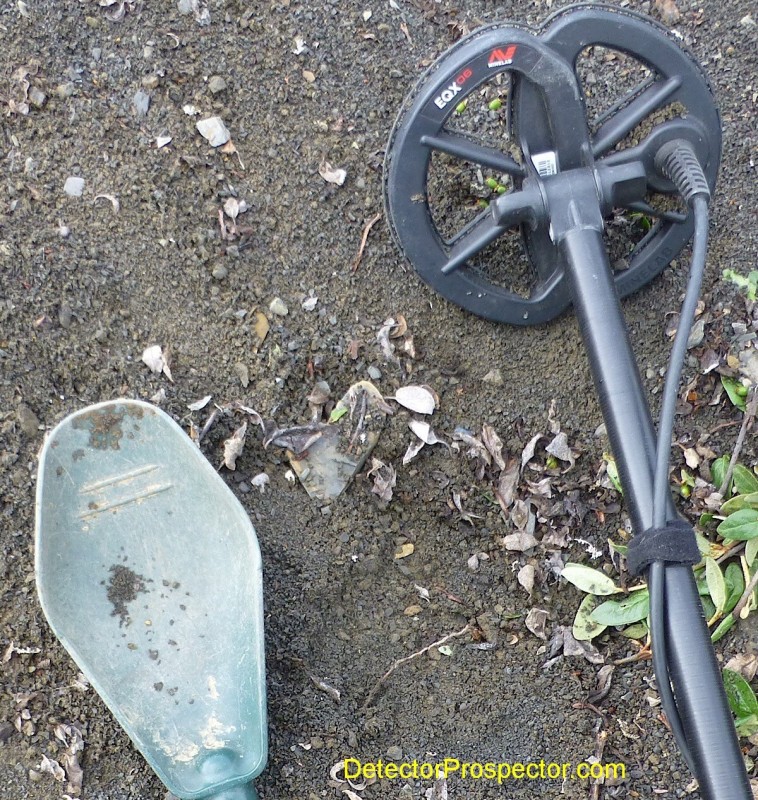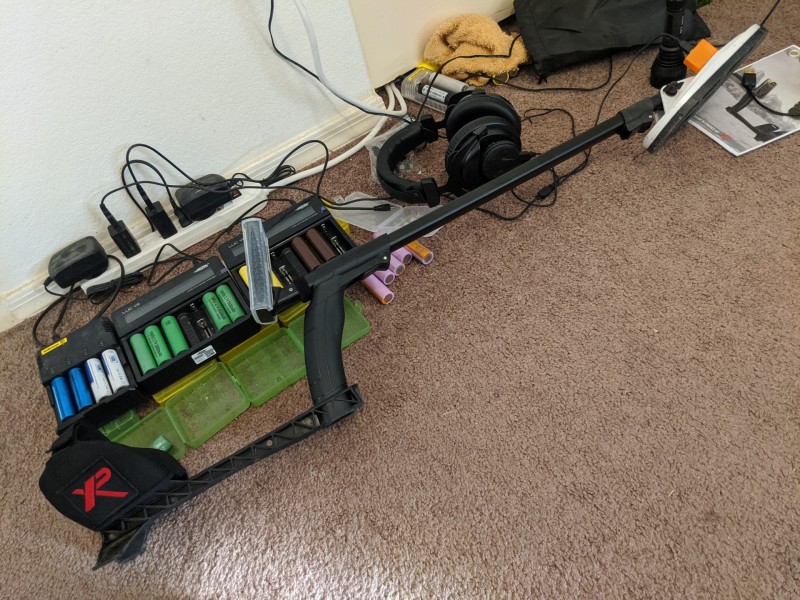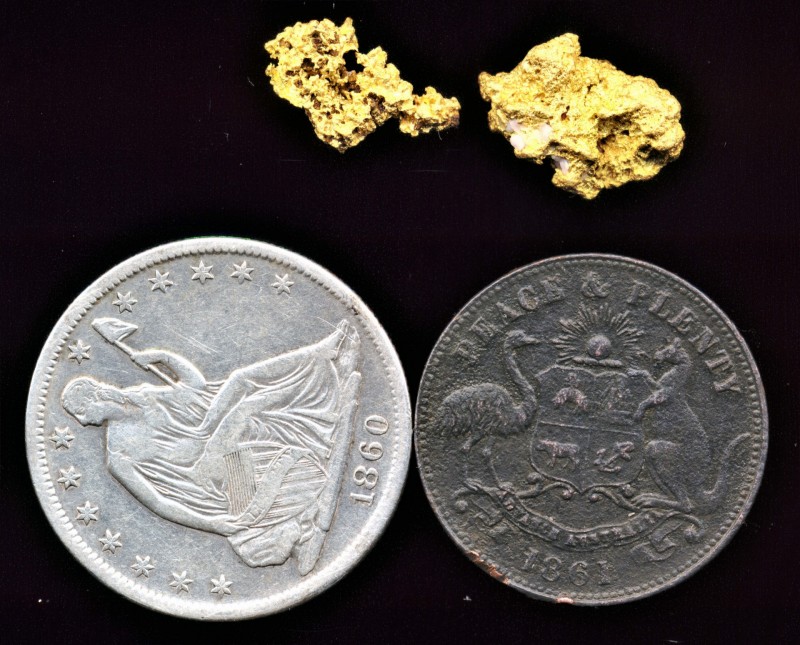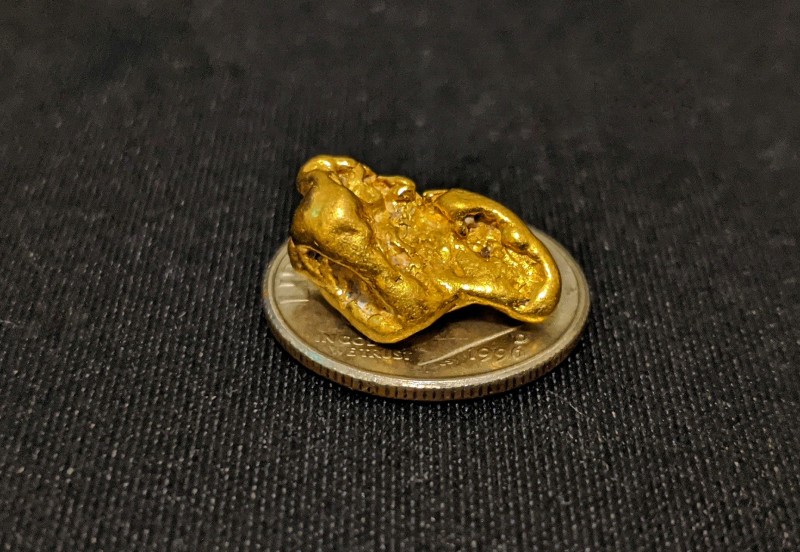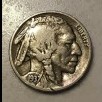Leaderboard
Popular Content
Showing content with the highest reputation on 12/03/2019 in all areas
-
I went to Rye Patch, NV last week and only had 9 hours of detecting with the GPX 5000. Got serious and followed some guidance from forum members and found 3 chevron nuggets (.6 gm, .3 gm and .3 gm) found 4" - 6" deep in heavily detected ground. Many thanks go out to Gerry with a great deal on the Minelab GPX 5000 and Rob's NF Evo 17 x 13 coil paired with the SteelPhase enhancer. Settings were: Gain 18 - 20, Deep, Sensitive Extra or Fine Gold, and a quiet Threshold so I could concentrate. Signals were obvious and clear, without the constant mineral & salt noise. I also have a GPZ 7000, but trusted the reliable GPX for this short trip. Bill4 points
-
3 points
-
3 points
-
Well i for one hope it does what its advertised to do. What are we on .... year 3 hear? As far as the Terra ... it seems Fisher is hoping to sell it more in a overseas market as a cheaper option. Im with you Steve if it knocks out upper coins and iron im good..... but hopefully it doesnt knock out 22k and 24K or any much smaller gold. That ill be testing. Most machines that process a signal for disc also loose depth..... its alledged this one wont. That to me seems unlikely..... but how much depth is more my question. Price will keep a lot of people from buying....... unless it really produces. We will get some hype and some nay sayers from the first batch..... which i plan on being a part of. IN THE WATER is the tell for me...... will it be better than what im using? I normally hunt in AM because my first goal is to just find a target..... so reverse disc works well. NOW how well will these switches hold up to that? Unfortunately ....... i break stuff just because above average use in the water. There apparently is going to now be a 10 hour battery....... but will it come with the machine or as an option..... because a 5 hour battery just wont work for me. I also would feel a lot more comfortable with a waterproof machine to 3 meters. BUT..... Carl said once the company decides the depth rating based on the IP of the components...... which could be understated..... hopefully. There REALLY needs to be a smaller coil than the 12" i believe for water use. That battery pack...... appears to be expensive. This advancement has been a long time coming...... im glad someone finally stepped up. Maybe now others will. OH... and come on Fisher...... those shaft locks are OLD SCHOOL proven to be a pain for beach hunting.3 points
-
Iffy Signals Dec 1, 2019 - We took the Simplex and Vanquish to a 1675 permission and compared some signals throughout the day.2 points
-
2 points
-
I got my first target right away, the .22 cal casing and then after that I only had one target remaining (low signal)...... The Orx let's you know if there are more targets in the hole believe me, I kept scanning and heard something was still in the hole, I dug a hole before in Rio Verde Arizona and found (5) nuggets in the very large and deep hole they are the dirty ones in this picture (dirty ones on the right)............. I .......2 points
-
Not everyone of that generation does.. I'm 19, don't use social media apart from forums, and don't own a smartphone. I spend my electronics money on metal detectors.2 points
-
I would say the video would be a great video to show how not to retrieve a nug. A small nug say .10gram wont be found that way. Get a second scope. No dirt is dumped till both scopes are scanned. The scope with no beeps gets dumped in a single pile away from the hole. Some times you get two targets, one in each scope. Scan twice dump once lol.2 points
-
Glad I don't have to worry about this. I have one of Steve's shafts and I love it. In addition to its light weight, sturdiness and choice of colors, it has made the task of shortening or lengthening the shaft quick & easy when I'm working the slopes.2 points
-
The TDI actually does have the ability to discriminate iron, although to retain depth you have to choose between detecting non-ferrous low conductors plus small ferrous items, or non-ferrous high conductors plus large ferrous items. It is possible to tune a TDI to completely reject iron, but when set up like that it is basically no better than most VLF detectors for depth. White's TDI Coin Settings Iron Discrimination with a White's TDI White's TDI For Coin Detecting In general however I'd not recommend a PI for foundation type areas unless you really like "out-of-the-box" type detecting.2 points
-
I'm hoping it can at least match the depth I am getting with my GPX 5000 at the beach. Real Iron discrimination?....... that would be super, If it handles EMI extremely well.......really super super 😄 And water proof ....hmmmm, OK I'll buy one. 😍2 points
-
Now I know why I need a25" NF coil to find coin here in Gippsland ,Vic Australia.😃 Giant_Gippsland_Earthworm2 points
-
Gold Nugget Detecting with the Minelab Equinox Metal detecting for gold nuggets is one of the most difficult detecting tasks, and learning to run a VLF detector in highly mineralized ground will challenge even the best detectorists. There is more to this subject then can be covered in a brief article but I will try and offer some tips to get people started with the Minelab EQUINOX for gold nugget detecting. Minelab Equinox with 6" coil at work gold nugget detecting Tiny nugget in scoop - the Equinox can find very small gold nuggets! The EQUINOX 800 has two modes that are not available on the EQUINOX 600 – Gold Mode 1 and Gold Mode 2. The two Gold Modes as far as I h e been able to determine are identical except for the default settings. Gold Mode 1 is set up with a default Recovery Speed of 6 and Gold Mode 2 is set up with a default Recovery Speed of 4. These modes employ a boosted audio that increases both in volume and pitch as a target is detected. This in turn accentuates the signal on tiny gold nuggets. The threshold is also different than the “reference threshold” employed in the other modes and is more responsive to ground changes, providing important audio feedback about changing ground conditions. The Gold Modes are similar to the threshold based all metal modes available on most VLF nugget detectors with a major difference. A target id number is displayed for strong targets and each target id number can be independently set to accept or reject. In this regard the Gold Modes are a hybrid mode with more discrimination capability than is available in normal threshold based all metal modes. Normal VLF nugget detecting relies on the operator having their ear very tuned into the threshold sound of the detector. Slight variations in the threshold tone can indicate potential targets. The threshold tone is also very sensitive to changes in the ground mineralization. This includes the so-called “hot rocks” which have mineralization different than the ground they reside in which makes the detector react to them as targets. The challenge is to get the detector to operate with a relatively smooth threshold as the coil is swept over the ground so that desired targets will stand out. If hot rocks are signaling with every sweep of the coil, then progress will be extremely slow if not impossible. Tuning a VLF detector to hunt nuggets starts with the theoretical most powerful settings, and then reduces those settings until the detector becomes stable. Every setting is a trade off, because making a detector more sensitive to gold also makes the detector more sensitive to mineralized ground and hot rocks. The key settings for the EQUINOX 800 in Gold Mode are: Frequency. Multi frequency is the default and the most powerful frequency setting, with 40 kHz and 20 kHz single frequency options. Multi is the most sensitive to gold, but also reacts the most to bad ground and hot rocks. The goal is to get the EQUINOX to run well in Multi but if bad ground or hot rocks make that impossible, going first to 40 kHz and then to 20 kHz will make the EQUINOX progressively less reactive to the ground and the hot rocks. Ground Balance. The default is ground tracking on. Tracking attempts to keep up with and smooth out the variations in the ground. In doing so it has a filtering effect and can possibly tune out the slight audio variations that come not just from the ground but from very small or very deep gold. Tracking off is therefore the most sensitive setting, with adjustments made via the Auto (pump) method or manually. Sensitivity. The range is 1 – 25 with a default of 20. Increasing sensitivity increases the audio response from all targets, plus the responses from things like electrical interference. Most importantly, too much sensitivity makes the ground itself into one giant target, and so if the detector refuses to ground balance properly then reducing sensitivity until a proper ground balance can be obtained is critical. The default of 20 can easily be too high for the worst ground, and settings in the mid to low teens may be necessary. Recovery Speed. The range on the EQUINOX 800 is from 1 – 8. The defaults are 6 for Gold Mode 1 and 4 for Gold Mode 2. Recovery speed as regards nugget detecting can be viewed as a smoothing filter. Higher settings act to smooth out audio responses from the ground and hot rocks. Lower settings enhance audio responses from weak gold signals, but also make hot rocks and bad ground stand out more. False signals from the coil bumping a rock also increase at lower settings. In general the EQUINOX will be easier to handle at higher Recovery Speed settings, with more careful coil control required at lower settings. Iron Bias. The range is 0 – 9 with a default of 6 in both Gold Modes. Lower settings reduce the chance of gold being identified as ferrous, while higher settings reduce the chance of ferrous items being misidentified as gold. Accept/Reject. The default is -9 through 0 rejected, 1 through 40 accepted. The discrimination range on the EQUINOX runs all the way into the ground signal, with ground signals in highly mineralized ground normally coming in at -9, -8, and possibly -7 though it depends strictly on the ground itself. Hot rocks can read almost anywhere, even in the positive number range in the mid-teens or elsewhere. Electrical interference is also likely to exhibit in the low negative number range. Any offending numbers including trash targets can be blocked directly, but the more numbers that are blocked or rejected come at a cost of slightly less signal strength on desired targets. Threshold. The range is 1 – 25 with a default of 12. This is normally set to be just loud enough to hear, but no more. Just a barely discernible tone. However, the threshold can also act as a backend filter. Once all other tuning has been completed, the threshold can be set lower until it is silent, or set higher than normal. Running silent can suppress small variations in the ground signal but also the weakest gold signals. Running the threshold higher than normal can smooth out weak variations, again with a subsequent loss on the faintest gold signals. My starting point (initial settings) for either Gold Mode are: Frequency: Multi Ground Balance: Auto (pump method) with manual tweaking Sensitivity: 20 Recovery Speed: 6 Iron Bias: 0 Accept/Reject: -9 through 40 accepted (either through the settings or by hitting the “Horseshoe button”) The main thing I am going to try and do is operate the EQUINOX in Gold Mode without blocking out or rejecting any target id numbers. The goal is to find settings that reduce and smooth out ground responses while reducing the signal from gold as little as possible. These two things fight each other and there are no perfect settings, but simply the best compromise possible. For some people that will mean making the machine very stable, while others may prefer hotter settings that require more audio interpretation from the operator. The first step is to find an area clear of trash, and walk a bit waving the coil over the ground. Chances are you will get lots of ground noise. Go into the settings and adjust the ground balance. This normally means pumping the coil over the ground while holding the accept/reject button (see the manual) until the ground response evens out. If the ground is highly variable with mixed hot rocks, waving the coil from side to side may work better than pumping the coil. With any luck the machine will settle right down. However, in bad ground it will not, and the solution normally will be to lower the sensitivity setting. Basically this just takes some experimentation, lowering the sensitivity and adjusting the ground balance until the detector reacts very little or not at all to being waved over the ground. If you can get the EQUINOX set to where no target id numbers are popping up at all as the coil passes over the ground but where you can still hear faint variations in the ground, you are there. Then it is simply a matter of going detecting, and digging every target that stands out above the faint ground variations present in the threshold tone. Gold can read anywhere from negative numbers all the way up into the 30’s so typical nugget detecting involves digging everything. However, most nuggets weighing under 1/10th gram will give a target id number of 1 or 2, nuggets under a gram in the single digits, and several gram nuggets reading in the teens and higher. The smallest or the deepest large nuggets will produce no target id number at all, just a variation in the threshold. In real bad ground you may have to not only reduce the sensitivity setting, but possibly even increase the recovery speed setting to 7 or 8. In ground that refuses to behave, switching to first 40 kHz and then 20 kHz will progressively detune the EQUINOX , making it easier to get a stable ground balance. Engaging ground tracking may also help smooth out the worst ground – you have to experiment. In severe ground all this may not work, with ground signals still coming in around the low negative numbers and possibly higher. Some hot rocks may read as positive numbers. This is where the EQUINOX can go to the next level. Go into the settings and reject or “notch out” the worst offending target id numbers. This will usually be -9, -8, and -7 but may include even higher numbers, including positive numbers. Block as few numbers as you can. Simply rejecting the bottom three negative numbers will usually settle the machine down a lot, especially if there is any residual electrical interference being encountered. Rejecting target id numbers does come at a cost in reduced signal strength on desired targets, but you may find now that the sensitivity level can be increased from one to several points, reclaiming that lost sensitivity. In theory if you can get the EQUINOX running stable with no target id numbers rejected you have the ideal situation. However, EQUINOX allowing some offending signals to be rejected with an attendant increase in the sensitivity setting may be the better way to go. It just depends on the situation. So far we have been trying to deal with bad ground by using various detuning methods. In low mineral ground you can go the other direction. If the detector ground balances immediately with a sensitivity setting of 20, then try higher settings. You can also try reducing the recovery speed setting from 6 to 5 or 4 or even lower. Each reduction of the recovery speed setting is fairly dramatic and you will find it suddenly very hard to get and hold a decent ground balance if you go too low with the setting. In mild ground however it can add substantially to the signal strength of the weakest targets. Finally, for the worst ground and for EQUINOX 600 owners we have other alternatives. There is no reason at all why the other modes cannot be used to nugget hunt. Park 2 and Field 2 are both very hot on small targets and offer the ability to use tones while nugget hunting. Prospectors who encounter salt lakes/salt flat situations would do well to remember the Beach modes as possible last ditch settings. Either Park 2 or Field 2 can make for very good nugget hunting modes. I prefer to use Park 2 as a base because by default Field 2 blocks out or rejects the key target id numbers 1 and 2. Small gold nuggets read there, so using Park 2 makes sure somebody will not accidentally reject nuggets in that range. You can use Field 2, but beware those blocked numbers and adjust accordingly. For Park Mode 2: Frequency: Multi Ground Balance: Auto (Ground pump method with manual tweaking) Sensitivity: 16 – 25 Recovery Speed 800: 4 - 6 (default is 6) Recovery Speed 600: 2 - 3 (default is 3) Iron Bias: 0 Accept/Reject: Everything accepted, rely on tones (alternative reject -9, -8, and -7 if too much ground feedback) I have suggested accepting everything, and then using the two tone mode to hunt by ear. If trash is minimal then set the tone break lower than normal, so that 0 and several negative numbers read as non-ferrous. This way you can have ground signals reading as low tones (and possibly at a lower volume) and signals from gold as higher tones. Again, this works well with both EQUINOX models. To sum up, I suggest trying to use the EQUINOX 800 in the Gold Modes with no target id numbers rejected. Tune up just like any normal nugget hunting detector, and dig all decent audio signals. Some nuggets may deliver a negative number response or no number at all. A secondary method for more difficult ground is to reject or block out offending ground and hot rock signals. And a third method for both EQUINOX 800 and 600 owners involves using the Park 2 mode as a nugget hunting mode. That should give people plenty to experiment with. Nugget detecting can be very challenging, but learning to do so means you will learn how to wring every bit of performance possible out of your EQUINOX , and that can benefit you in other areas of detecting as well. Good luck! Steve Herschbach DetectorProspector.com Earlier post on same subject Gold found in Alaska by Steve with Minelab Equinox Gold found in California and Nevada with Minelab Equinox1 point
-
The Fisher Impulse Gold is a new ground balancing pulse induction (GBPI) metal detector with probable availability in 2021. The new Fisher Impulse Gold is a gold prospecting model being developed alongside the Fisher Impulse AQ model, which is intended for beach and water hunting. The Impulse Gold is expected to offer excellent depth and superb sensitivity to small gold nuggets due to an very low pulse delay capability. The compact design and light weight is also attracting a lot of attention. A major design difference from the AQ model will be the inclusion of a ground balance control to deal with mineralized ground conditions. There may or may not be any ferrous discrimination features as are offered in the Fisher Impulse AQ due to the almost infinite range of target id numbers spanned by naturally occurring gold nuggets. It is likely that this model will also find applications with relic hunters, as has been the case with previous pulse induction gold prospecting metal detectors. Production of the AQ Limited ceased in December 2020. According to this post, the final Impulse AQ will be released by July 2021, and it will sell for between $2800 and $3500. How this relates to the Impulse Gold model is unknown at this time. The photo below shows the Fisher Impulse AQ prototype - the Fisher Impulse AU is probably of similar design although testing has been mentioned with a smaller coil. Fisher Impulse Gold Prototype New information will be added here when available. All information here is very preliminary and subject to change, especially pricing and final specifications. Everything is really just guesses based on the Fisher Impulse AQ plus a couple things mentioned on the forums, such as the coil size. Terra Should Not Be Long Terra 8" Coil Latest pulse induction technology Handles highly mineralized ground Very sensitive to small gold Rechargeable batteries Light weight, ergonomic design 8” mono coil standard? Optional 12.5” mono coil? Detector complete with battery under five pounds Price US$2499 -$2999? First Texas - Bounty Hunter, Fisher & Teknetics Metal Detector Forum1 point
-
Hi, all! I just wanted to mention that in the spirit of the Holidays, Steve's Detector Rods will be giving away one carbon-fiber complete Equinox shaft (upper shaft and lower rod), AND one carbon-fiber Equinox lower rod, to two lucky U.S. winners. Two separate drawings will be held on Dec. 18, one for the complete shaft, and a second for the lower rod. Entry into the drawings is completely free, with no purchase required -- and the entry period is open from now, through 11:59 PM on Sunday, Dec. 15. Additionally, ALL entrants into either drawing will qualify to receive 10% off of any item purchased through Steve's, for the entire month of December. For additional information, including details and eligibility, please visit Steve's Facebook page, at https://www.facebook.com/stevesdetectorrods Thanks! Steve1 point
-
Went out for a bit earlier today and found these. The quarter was shallow on edge of what was a small orchard. The locket hinge still works but the photo has disolved away. Locket was pretty deep under a good size rock. Think it was silver plated at one time. Grounds starting to freeze so might be getting close to the end of the season. I'll call it a day when my digger makes a clank sound and I can't dig.1 point
-
1 point
-
1 point
-
1 point
-
The selling point for PI is more depth in mineralized ground once you can’t find anything else good anymore with a VLF. If you have a great location where lots of finds were made, but a VLF no longer produces anything, then a PI can turn up more good finds. The price paid is minimal discrimination capability. This is why virtually all serious gold prospectors and many relic hunters end up going PI. The VLF detectors eventually tap out completely and so to stay in the game you either go somewhere else or go PI. The main thing is the targets have to be worth it. I dig trash all day long looking for just one gold nugget. I prefer PI detecting for beaches for the same reason. Many relic hunters feel the same way. But is it worth digging a ton of trash around a foundation for an Indian Head penny? Not for me. If I thought a gold coin was there however that might be a different deal.1 point
-
So no benefit of using a pi then. That saves me about a grand and a lot of digging. Thanks.1 point
-
Interesting map,never knew it was as big as that till you have all the other European countries combined inside the Aussie footprint......just shows us how lucky the UK being so small but steeped in history we are. That for posting that image.1 point
-
Give Rob a text at Rob Detector Sales . The number to text only is 602-909-9008 . Tell him that Chuck Anders said to see him about the ORX . See if he will give you any discount on it . Using my name won’t get you anything but maybe it will. Rob is a great guy to deal with and he will be there for you long after the sale. Chuck1 point
-
1 point
-
2Valen -- teenage grandkids are definitely expensive! 😉 I would welcome the chance to build you a shaft, if they don't drain your bank account! 😉 Steve1 point
-
That reminds me to get my dogs heart worm pills, I would hate to see something like that come out of him. The poor guy would die from just 1 of those!1 point
-
Glad you said that.... I surely meant no ill intent or disrespect in my earlier comment, just speaking truth...imo1 point
-
We are not nay saying him. It is valuable help that if he follows he will keep adding to his growing stack of nuggets.1 point
-
Pin pointers are not that great for gold Nugs. Yes they can be used. They just dont react to small nugs very well. Now Australia type big hogs yep they find those.1 point
-
The ORX is set on high mode because it's loud, I use headphones to turn it down using the headphones to hear just a quiet humm ..... and to have complete silence I got new headphones (Quest Wirefree Pro)..... Don't like the little legs of the ORX behind my ears...... The only legs I want wrapped around my head are my old lady's.1 point
-
1 point
-
1 point
-
Steve - You really think any of us are going to give you a year to try it out before you report back to us? Good chance you'll have the entire West Coast cleaned out by then. 😜1 point
-
So far in 2019 I got $18.00 dollar coins back in change. The cashiers thought they were quarters I gave up on explaining what they are.1 point
-
1 point
-
I found out that my home has been 2 or 3 churches, Masonic Lodge and back to a church again. I have since turned it into a home but still have the corner stone in the front corner of the place. I have dug up most of the same things that you have and by the sidewalks found silver from the early 1900's and even a 1889 IH within inches of the sidewalk. All over the yard has been burn piles, and next to them I have found coins. I have found a gold charm bracelet, and more coins near the old trees. I have yet tried the parking lots as they are gravel and I know what kind of mess they will leave for my wife to yell about. Keep checking all signals that you get because you will find a wide range of things mixed in with the trash.1 point
-
A process known as Bioturbation is a very significant factor in coin sink. Essentially, earthworms disturb the soil around the item, until one dry/wet/cold/whatever day, the conditions allow it to drop 2 or 3 mm. Repeat this for 100 years and your target is 20cm ( 8 inches) down. If the ground is inhospitable to worms, the sink is much slower. Unfortunately for us, earthworms tend to live in the top 30cm ( 12" ) of soil, because that's where the plant matter they eat is located.1 point
-
Here are some Oregon treasures and mines to look for when you get a chance! https://thatoregonlife.com/2019/11/5-legendary-missing-treasures-in-oregon-you-may-not-know-about/1 point
-
iffy signals also did a Nokta/Makro Simplex+ vs Garrett AT Pro video. When asked on YouTube what he thought of Simplex vs Vanquish, read below..... “MD Melbourne15 hours ago Quite a nice detector iffy, In your opinion what do you prefer this or the simplex? REPLY Iffy Signals 15 hours ago Hey Jim, i prefer the Minelab because of the multi freq and the 5 tones in all modes. Simplex is stuck in two tones for there deep mode. Vanquish has 5 tones for all modes. Anyone who likes the Equinox will most likely like the Vanquish. Other than the fact that it looks like a Fire Truck 🚒. Take care bud.”1 point
-
I hope you wont take this the wrong way, but the comically bad technique, filming and target recovery, combined with the shaking hands with the first hint of gold made the whole video charming and enjoyable. Well done!1 point
-
Your mod does look rock solid, should last. I have the Predator Tools model and it’s still going strong after 12+ years of use. Mr. Lesche is the owner of the company and still manufactures his original and iconic hand digger in addition to a variety quality shovels. He did start the company you bought from many years ago but has not been associated with them for years. I have a couple of his products and they are all very well made.1 point
-
Steve I myself have never used headphones with my ORX and I don’t find that ever being a problem for me. I’m one that don’t hear a word my wife is saying but my ORX comes through loud and clear. I too find myself reaching more for the ORX not just because of less weight but trusting in it over another detector. Chuck1 point
-
Mountain Lake Detecting - Metal Detecting is a great Hobby, teaching the younger generation how to find hidden treasures underground is a great way to spend the day and pass along knowledge . Me and my friend Adrian hunt a Mountain Lake's Beach for hidden Gem's and Treasure's from Hot wheels to Pull tabs see what we uncover on the adventure (SG 014)1 point
-
Well Steve, the Orx is an amazing detector. Orx w/ 9" coil is better in iron than the Equinox w/ 11" coil. I would say equal with Equinox using 6" coil. Will not be get rid of either. I also have the waterproof kit for the Orx too. The Orx doesn't false like the Equinox in iron. To bad the coils cost so much for the Orx. Looking forward to seeing the Fisher AQ too.1 point
-
Drive by poster. I guess if my questions are not worth the effort neither are yours Mr. Nugget, but thanks anyway! Too bad really as you would have learned a lot more engaging with us. The idea of a mars rover wandering around digging nuggets by itself is nice, but I know if I did that somebody is going to see it and load it plus the gold up in their pickup and be gone with it. Nice fantasy though. Maybe with radar enabled gatling gun perimeter defense system?1 point
-
This was a rather large update. Not so much in any of my reviews but a major shuffle in prices which changes the equation on some units as far as desirability. Steve's Guide to Gold Nugget Detectors Here are the highlights. THIS IS NOT THE FULL REVIEW, IT’S THE CHANGES ONLY.... FOLLOW THE LINK ABOVE TO READ THE FULL REVIEW! The Nokta/Makro Gold Racer dropped from $599 to $509 putting it in direct competition with the Fisher Gold Bug (basic model $449) and Minelab X-Terra 705 Gold at $499 plus the Fisher Gold Bug Pro at $549. That's a killer deal for a 56 kHz full featured detector. All the Nokta/Makro models had serious price drops, as it appears the U.S. importer was keeping prices artificially high. Nokta/Makro stepped in and corrected the situation, leading to the decreases. The Nokta/Makro Gold Kruzer was reduced from $749 to $636, a couple bucks less than the Garrett AT Gold but the Kruzer is 61 kHz and comes with two coils. This effectively puts the AT Gold out to pasture as a “new with warranty” nugget detector option in my opinion unless Garrett lowers the price. Waterproof, built in rechargeable battery, wireless, 61 kHz and two coils... the Gold Kruzer may be the best package price available right now in a VLF nugget machine. The Tesoro Lobo SuperTRAQ was deleted from the list. Tesoro is out of business, and although a few of these may be on dealer shelves still the is no warranty on them so they are gone as far as I am concerned. The Nokta/Makro AU Gold Finder with two coils came down from $799 to $679, the same price as the now departed Tesoro Lobo. The Minelab Gold Monster went UP to $849! I still have it as a "Steve's Pick" but that could change to the White's Goldmaster 24K if White's gets more coils out. More and more users are giving the 24K a thumbs up. The 24K is $729 but do remember the Monster comes with two coils and the 24K just the one now that the Intro deal is over. My "Steve's Picks" are aimed at first time buyers so I am sticking with the Monster for now due to simplicity compared to other less expensive but more complicated options. The same reason I am still showing the Gold Bug basic as a pick - it's simple and effective. The XP ORX dropped from $899 to $795 with a $649 wired headphone option. At $649 it's a good deal. A note on the Minelab GPX 4500 - rumored to be discontinued soon but still on Minelab website as current. And finally Minelab SDC 2300 increased from $3750 to $3799 No doubt about it, competition really heated up in 2019 with lots of pressure on VLF prices. Now if we could get some competition going in the PI detectors in both price and ergonomics things would be great!1 point
-
For what it's worth I appreciate this website. It's quickly become my favorite Nugget hunting website. I'm just getting back into the hobby and have learned and relearned so much here about the hobby here. Some things have changed but many things no so much since 06. But I feel like there has been progress though, not by leaps and bounds but progress none the less. I'm still waiting as all of us are for the PI detector that is light, waterproof, wireless and with excellent discrimination and modes for every type of metal detection. Terry1 point
-
Hello OroSeeker, As far as fonts go, do nothing and the forum defaults to Arial. You do not have to chose a font, just type away. Sorry if I came off harsh but I am just being honest. You predicated this idea on your mom being of failing health and your finances non-sustainable. I am looking at this from that perspective, the perspective of needing money in serious circumstances. From where I sit I have prospected for gold my entire life and am doing this literally as this thread develops. I was swinging a detector prospecting all day yesterday and will be doing so again in an hour for the entire day. And the next, and the next. I know intimately what we are talking about here. I am in good gold country swinging the most powerful prospecting detector currently available, a Minelab GPZ 7000. The country I am in has vastly more chances of my wandering over a shallow overlooked gold vein than Minnesota, where your chances are so close to zero as to be exactly that. Most of us are looking for gold nuggets because that is the best way to find gold with a metal detector, but the ground all of us swing over could also reveal shallow rich gold veins or pockets. They do get found from time to time, but they usually are the sort that give up a few ounces of gold as best. They are not some magic bonanza. I can recall one example in Austrlalia off hand where a vein found in Australia with a metal detector actually produced enough gold to make a difference in life. This is extreme long odds stuff. I do spend time, and in fact spent half the day yesterday on a walkabout looking for a new patch or a shallow gold vein. I do it all the time. I detect gold shed off of veins all the time. A gold vein in place is usually just a bunch of quartz with no gold to be seen, but if enough of the quartz decomposes over millennia a stray piece of gold is liberated now and then to create little residual deposits that can be worked with a detector. If you were with me right now I could drive you to and show you many in place gold veins. They are not the gold filled things I think you are imagining. They have gold measured in fractions of an ounce per ton. Rich gold veins the likes you seek exist mostly in the imagination. Again, your issue is not detectors of detecting methods, it is learning more about the nature and reality of gold veins and gold deposits in general. If you were just a casual person with some money to blow I would indeed say go for it. But the situation you have presented is different. You portray yourself as somebody with some serious issues that require some income. I would be doing you an extreme disservice in suggesting that chasing gold with a metal detector is a wise way to approach that issue. That is all I have to say on that subject. If you do just want to get into prospecting and metal detecting that is great, and we are here to help.1 point
-
Old thread, but useful. $9000 or even $7000 detectors are a commercial dead end without $2000+ per oz gold except for a few full timers in rich countries. The Africans want a machine to tell them where to have the other 30 guys with no detector dig. The Aussies want a detector to find fist sized nuggeta at 3 feet, but then they try and dig them up LOL. Here in what the Canadians call "North America" we want a $1500 detector which is light, ignores most hot rocks, deals with moderate to bad mineralization and gets good depth with no "holes". This would also sell like hotcakes in Africa, South America and Asia. Minelab will never do it, they are fixated on high margin. Garrett could do it tomorrow, but strangely won't. Fisher might be able to do it with their new super gold detector, but who knows when. Oh well. I found about 10,000 ounces of gold on Friday here in Abu Dhabi, but the guys with the H&K submachine guns in the gold market discouraged me from prospecting.1 point




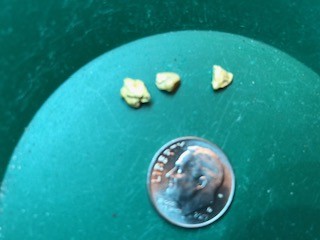

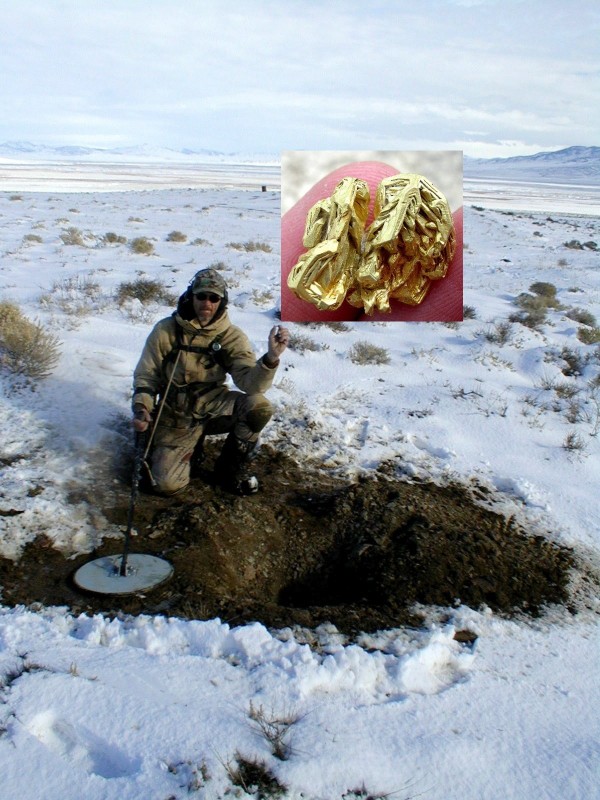
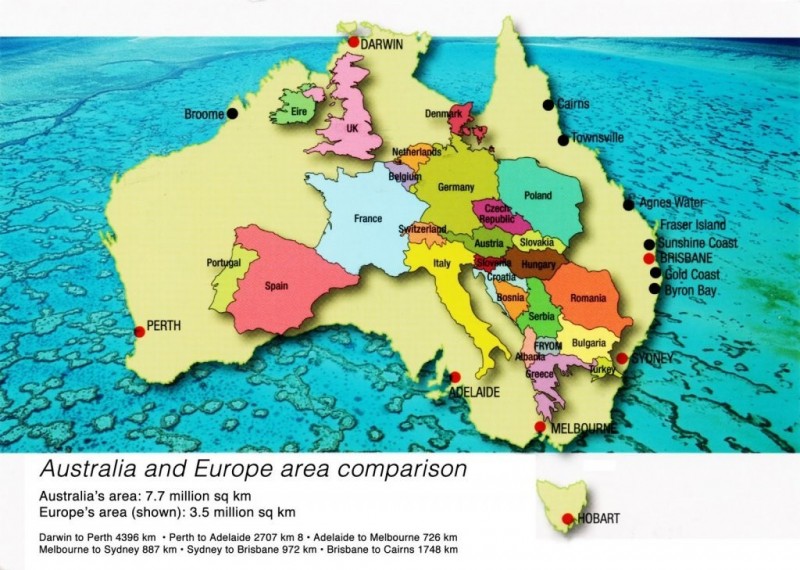

.thumb.jpg.77e4cb5bf39d44bdd2050d2edb7dfdb1.jpg)

